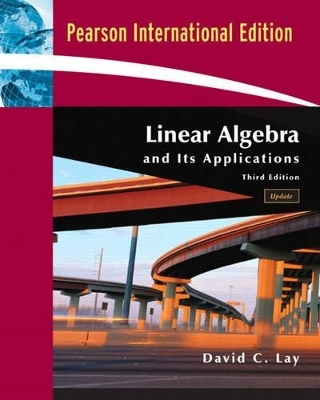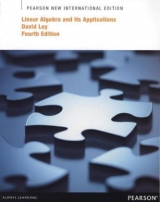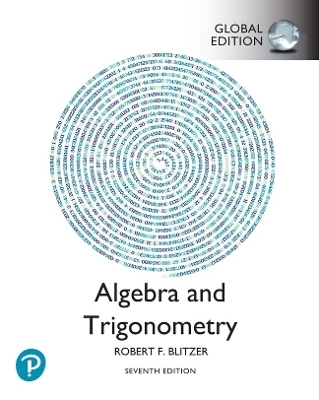
Linear Algebra and Its Applications with CD-ROM, Update
Pearson
978-0-321-31485-7 (ISBN)
- Titel erscheint in neuer Auflage
- Artikel merken
David C. Lay holds a B.A. from Aurora University (Illinois), and an M.A. and Ph.D. from the University of California at Los Angeles. Lay has been an educator and research mathematician since 1966, mostly at the University of Maryland, College Park. He has also served as a visiting professor at the University of Amsterdam, the Free University in Amsterdam, and the University of Kaiserslautern, Germany. He has over 30 research articles published in functional analysis and linear algebra. As a founding member of the NSF-sponsored Linear Algebra Curriculum Study Group, Lay has been a leader in the current movement to modernize the linear algebra curriculum. Lay is also co-author of several mathematics texts, including Introduction to Functional Analysis, with Angus E. Taylor, Calculus and Its Applications, with L.J. Goldstein and D.I. Schneider, and Linear Algebra Gems-Assets for Undergraduate Mathematics, with D. Carlson, C.R. Johnson, and A.D. Porter. A top-notch educator, Professor Lay has received four university awards for teaching excellence, including, in 1996, the title of Distinguished Scholar-Teacher of the University of Maryland. In 1994, he was given one of the Mathematical Association of America's Awards for Distinguished College or Unviersity Teaching of Mathematics. He has been elected by the university students to membership in Alpha Lambda Delta National Scholastic Honor Society and Golden Key National Honor Society. In 1989, Aurora University conferred on him the Outstanding Alumnus award. Lay is a member of the American Mathematical Society, the Canadian Mathematical Society, the International Linear Algebra Society, the Mathematical Association of America, Sigma Xi, and the Society for Industrial and Applied Mathematics. Since 1992, he has served several terms on the national board of the Association of Christians in the Mathematical Sciences.
Chapter 1 Linear Equations in Linear Algebra
INTRODUCTORY EXAMPLE: Linear Models in Economics and Engineering
1.1 Systems of Linear Equations
1.2 Row Reduction and Echelon Forms
1.3 Vector Equations
1.4 The Matrix Equation Ax = b
1.5 Solution Sets of Linear Systems
1.6 Applications of Linear Systems
1.7 Linear Independence
1.8 Introduction to Linear Transformations
1.9 The Matrix of a Linear Transformation
1.10 Linear Models in Business, Science, and Engineering
Supplementary Exercises
Chapter 2 Matrix Algebra
INTRODUCTORY EXAMPLE: Computer Models in Aircraft Design
2.1 Matrix Operations
2.2 The Inverse of a Matrix
2.3 Characterizations of Invertible Matrices
2.4 Partitioned Matrices
2.5 Matrix Factorizations
2.6 The Leontief Input=Output Model
2.7 Applications to Computer Graphics
2.8 Subspaces of R^n
2.9 Dimension and Rank
Supplementary Exercises
Chapter 3 Determinants
INTRODUCTORY EXAMPLE: Determinants in Analytic Geometry
3.1 Introduction to Determinants
3.2 Properties of Determinants
3.3 Cramer’s Rule, Volume, and Linear Transformations
Supplementary Exercises
Chapter 4 Vector Spaces
INTRODUCTORY EXAMPLE: Space Flight and Control Systems
4.1 Vector Spaces and Subspaces
4.2 Null Spaces, Column Spaces, and Linear Transformations
4.3 Linearly Independent Sets; Bases
4.4 Coordinate Systems
4.5 The Dimension of a Vector Space
4.6 Rank
4.7 Change of Basis
4.8 Applications to Difference Equations
4.9 Applications to Markov Chains
Supplementary Exercises
Chapter 5 Eigenvalues and Eigenvectors
INTRODUCTORY EXAMPLE: Dynamical Systems and Spotted Owls
5.1 Eigenvectors and Eigenvalues
5.2 The Characteristic Equation
5.3 Diagonalization
5.4 Eigenvectors and Linear Transformations
5.5 Complex Eigenvalues
5.6 Discrete Dynamical Systems
5.7 Applications to Differential Equations
5.8 Iterative Estimates for Eigenvalues
Supplementary Exercises
Chapter 6 Orthogonality and Least Squares
INTRODUCTORY EXAMPLE: Readjusting the North American Datum
6.1 Inner Product, Length, and Orthogonality
6.2 Orthogonal Sets
6.3 Orthogonal Projections
6.4 The Gram-Schmidt Process
6.5 Least-Squares Problems
6.6 Applications to Linear Models
6.7 Inner Product Spaces
6.8 Applications of Inner Product Spaces
Supplementary Exercises
Chapter 7 Symmetric Matrices and Quadratic Forms
INTRODUCTORY EXAMPLE: Multichannel Image Processing
7.1 Diagonalization of Symmetric Matrices
7.2 Quadratic Forms
7.3 Constrained Optimization
7.4 The Singular Value Decomposition
7.5 Applications to Image Processing and Statistics
Supplementary Exercises
ONLINE ONLY Chapter 8 The Geometry of Vector Spaces
INTRODUCTORY EXAMPLE: The Platonic Solids
8.1 Affine Combinations
8.2 Affine Independence
8.3 Convex Combinations
8.4 Hyperplanes
8.5 Polytopes
8.6 Curves and Surfaces
Supplementary Exercises
ONLINE ONLY Chapter 9 Optimization
INTRODUCTORY EXAMPLE: The Berlin Airlift
9.1 Matrix Games
9.2 Linear Programming — Geometric Method
9.3 Linear Programming — Simplex Method
9.4 Duality
Supplementary Exercises
Appendices
A Uniqueness of the Reduced Echelon Form
B Complex Numbers
Glossary
Answers to Odd-Numbered Exercises
Index
| Erscheint lt. Verlag | 5.5.2006 |
|---|---|
| Sprache | englisch |
| Maße | 232 x 208 mm |
| Gewicht | 900 g |
| Themenwelt | Mathematik / Informatik ► Mathematik ► Algebra |
| ISBN-10 | 0-321-31485-9 / 0321314859 |
| ISBN-13 | 978-0-321-31485-7 / 9780321314857 |
| Zustand | Neuware |
| Haben Sie eine Frage zum Produkt? |
aus dem Bereich


